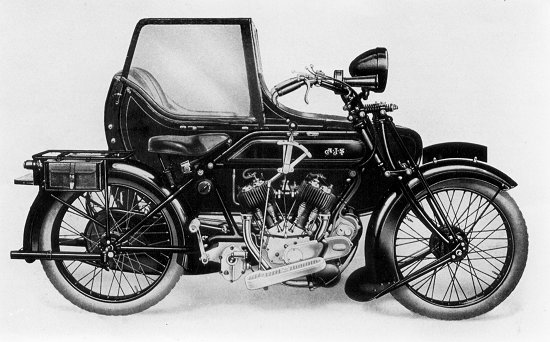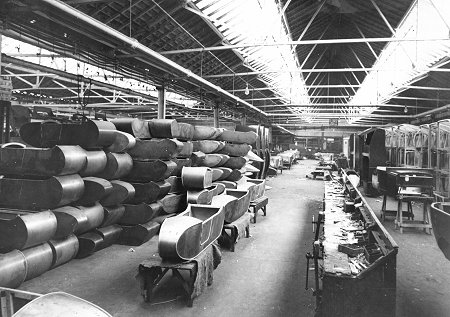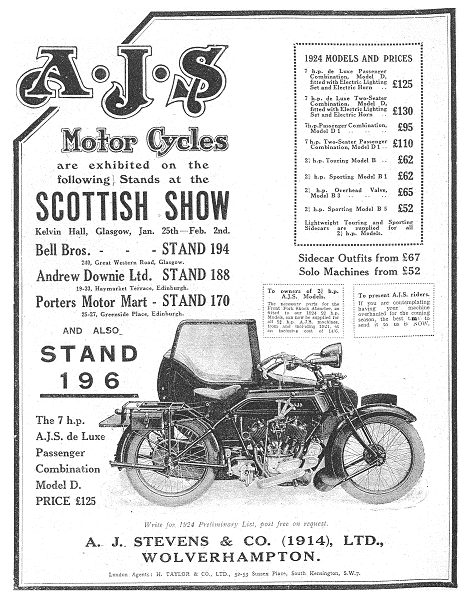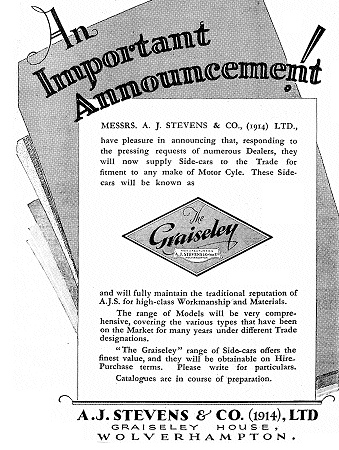Sidecars and C. W.
Hayward
| In 1913 A.J.S. introduced a version of the model 'D'
motorcycle with a coachbuilt sidecar. The sidecars were
purchased from local manufacturer C. W. Hayward. |
|

Charles William Hayward in 1926. |
Charles William Hayward was born in Wolverhampton on 3rd
September 1892 and educated at St. John's School in
Cleveland Street. Whilst still at school he helped his
grandfather, who had a small lock making business in Church
Lane. Charles used to collect brass castings from a foundry
in Skinner Street during his dinner break, and on Saturdays
would deliver finished locks to factors in Wolverhampton and
Birmingham. He started work as an
engineering apprentice with Joseph Evans, Culwell Foundry,
Heath Town.
At the age of 19 he rented a 100ft x
30ft workshop in a coalyard off Church Street, for 2
shillings and 6 pence a week. He employed a craftsman to
assist him in the production of patterns for the engineering
trade. |
| In the first two years he made £2,000, which in those days was a
large sum of money. With the development of the cycle and
motorcycle industry he began to produce motorcycle sidecars
for Sunbeam, in a small workshop in Sunbeamland. Sales were
good and the pattern making business was transformed into
sidecar production.
The sidecars were built to a very high
standard using an all steel, welded body, with a sprung
tubular steel chassis. A.J.S. became a good customer,
purchasing sidecars for the model 'D' combination, which sold
extremely well. The combination sold for 84 guineas for the
basic machine, or 87 guineas with easily interchangeable
wheels. Charles married Hilda Arnold in 1915 and sometime
later moved into 'Rosedale', Dunstall Road. |
| The luxurious sidecars were extremely
well fitted out with 'Leverine' leather upholstery, and
fully sprung.
A weatherproof hood was available as an extra.
During World War One A.J.S. worked flat out to fulfil
wartime contracts for the War Office and the Russian Army,
supplying large numbers of military motorcycles. |

A 7.99hp. de luxe passenger
combination from 1925. |
| Charles Hayward also did well, receiving large orders
for military sidecars, ammunition carriers, and machine gun
carriers.
For the first two years of the war
A.J.S. continued to produce motorcycles for the civilian
market. Two new passenger combinations were introduced in
1915. The first, an updated version of the 6hp. model ‘D’
sold for 88 guineas. The second, the new model ‘A’ was
a smaller version with a 4hp. V twin engine. It sold for 81
guineas. A full set of weather equipment was available for
both models as an extra. |
|

Joe Stevens senior and his 'Sociable' in 1915. Courtesy of
the late Geoff Stevens. |
1915 saw the introduction of the A.J.S.
'Sociable'.
It consisted of a model 'D' motorcycle with a 2 seater
sidecar in which the occupants sat side by side.
The person
nearest the motorcycle could control the machine, and steer
it by means of a tiller.
The idea wasn't very popular and
only a few were made.
|
| Harry Stevens had one of the machines
and went out for an afternoon ride with his wife Annie.
They
had a serious accident near Newport in Shropshire, when they
were in collision with a car.
Harry was badly injured after
being thrown some distance along the road. Annie only
received a few cuts and bruises.
The sidecar was completely
destroyed in the accident. |

Mr. and Mrs. Jack Clark of Wearwell in their 'Sociable'. Courtesy of
the late Geoff
Stevens. |
|
In November 1916 the Ministry of
Munitions prohibited the manufacture of motorcycles for the
civilian market, and so until the end of the war A.J.S. and
C. W. Hayward only produced products for the military.
Due to a large increase in sales,
Charles Hayward had to look for larger premises so that
production could be stepped up. He found empty premises in
Stewart Street that belonged to Star. He rented the factory
and moved there in 1916. |
|

From 'The Motor Cycle' 2nd February,
1922. |
After the war, civilian market
restrictions were lifted in January 1919, and A.J.S.
developed a 6hp. 3-speed 'de-luxe' model 'D' combination
featuring a luxurious sidecar. The model ‘D’ had a new style
saddle tank, detachable cylinder heads, and used some of the
techniques developed by A.J.S. for their wartime military
machines.
The sidecar was spacious and beautifully
upholstered in leather. Three large 'Cee' springs were
fitted to the back and front of the chassis to provide
excellent suspension, and weatherproofing was fitted in the
form of a folding hood and cover with side curtains and
apron.
Other features included a tool locker,
and a spare wheel on the back, that was interchangeable with
the wheels on the motorcycle. Due to inflation prices varied
from 135 guineas to 190 guineas.
The machines were a great
success, and C. W. Hayward, who also made sidecars for most
of the leading motorcycle manufacturers, became the largest
sidecar manufacturer in the world. |
|
Joe Stevens’ first wife Sarah Ann died
in 1906. He eventually married Charles Hayward's mother, so
that Charles became the Stevens brothers' step-brother. In
1920 A.J.S. took over Charles' company and purchased the
Stewart Street factory. The company still continued to trade
as C. W. Hayward, with Charles as Managing Director.
At the time, motorcycling had become
extremely popular, sales rocketed, and the Stewart Street
factory worked flat out. Charles was appointed to the
A.J.S. Board on 23rd November 1921. In the same year A.J.S.
launched a more powerful version of the model ‘D’, powered
by a 7hp. V twin side valve engine.
In 1922 a new lightweight sidecar was
introduced for use with the new 2¾hp. model 'B'. The sidecar
option included a storm proof apron and sold for £25.0s.0d.
The demand for sidecars became greater than ever, and so
A.J.S. decided to look around for larger premises because of
the cramped conditions in Stewart Street. |
| In 1922 the Briton Car Company, who
coincidentally used to occupy the Stewart Street works
before A.J.S., went into voluntary liquidation. Their Lower
Walsall Street works was put up for sale, and Page & Sons,
Estate Agents sold the Walsall Street factory on October 3rd
1922, for £7,000 to A.J.S. Before the end of 1922 the
sidecar business moved to Lower Walsall Street and by the
end of 1924 the factory had been expanded to cover 150,000
square feet.
In the same year Charles' son Jack was born at
'Rosedale'. |

The sidecar erecting shop at Lower
Walsall Street. |

One of Charles Hayward's Guy
lorries, loaded with sidecars. Charles Hayward is
possibly standing inside. Courtesy of David Clare. |
|

From 'The Motor Cycle' 31st January,
1924. |
Sidecars were still produced for a
large number of motorcycle manufacturers, helped by the
exploits of the company’s competition manager, Frank Giles
and his wife, Adelaide, who became well known because of
their many successes in sidecar trials events.
Sidecars continued to sell extremely
well until the emergence of the affordable light car in
1925, thanks to the efforts of manufacturers such as Austin
and Morris.
The Board decided to offset the falling sales by
introducing a range of commercial sidecars aimed at door to
door delivery or service work. A fire fighting sidecar was
also introduced, complete with a Merryweather fire pump,
ropes and axes.
Several prototype lightweight, collapsible
caravans were also produced. They came complete with cooking
utensils, cups, saucers, plates and cutlery, but were never
put into production. |
|
In 1927 A.J.S. secured a long term
contract to manufacture fabric covered car bodies for the Clyno 'Nine' light car, and in 1928 the whole A.J.S. sidecar
range was covered in the same material.
Before the year was
out Charles Hayward left Wolverhampton and moved to London
to pursue a career as a stockbroker and industrialist. His
position in the company was taken over by Joe Stevens
junior.
Sidecars were built by teams of six men
consisting of a team leader and 5 workmen. All sidecars were
carefully inspected before leaving the factory.
Any
unsatisfactory work would result in the sidecar being
returned to the team responsible, who would be expected to
remedy the problem in unpaid time.
Customers included Ariel, Brough, Excelsior, Scott, Sunbeam, Norton, and Swallow, one
of the best customers. |

From 'The Motor Cycle' 19th March,
1925. |

Frank and Adelaide Giles, who took
part in the London-Gloucester-London Trial on 10th December,
1927. They completed the course without losing any points,
and won a first class award. From an A.J.S. advert dated
December 1927. |
The entire sidecar range was updated in
1929 to match the new range of motorcycles. There were 8
passenger sidecars, and 5 commercial sidecars.
Disaster struck on 11th February, 1929
when Clyno went into liquidation, ending the important
contract for car bodies.
This had been essential to the
future of production at Lower Walsall Street because of the
continuing decline in the sidecar market. It ensured
full-time working for the large number of staff, and funded
the project to develop A.J.S. commercial vehicles.
In order
to offset the loss of the contract, A.J.S. decided to produce
its own light car, the A.J.S. ‘Nine’.
|

An advert from 'The Motor Cycle', 7th July, 1927.
|
Frank and Adelaide Giles on Blackermill Hill
during the 1926 International Six Days Trial.
They finished in first
place without the loss of a single point, and won a gold medal.
In
the same year they also made the fastest sidecar time in the high
speed test at Brooklands. |
 |
 |
Frank and Adelaide Giles making a meteoric ascent of Sandy Lane.
From 'The Motor Cycle' 8th March, 1928. |
|
Frank and Adelaide Giles crossing the High
Water Splash in the 1928 Victory Trial on his 3.49hp. outfit.
They
went on to win the trial and were awarded the 'Olai' cup. |
 |

An advert for Graiseley sidecars from 'The
Motor
Cycle', 12th September 1930.
Courtesy of the late
Jim Boulton. |
Sidecars continued to be produced under
the C. W. Hayward name until September 1930 when the
'Graiseley' name was adopted.
For the first time, sidecars
were supplied to motorcycle dealers, so that they could be
fitted to almost any make of machine.
In 1931 the company was in financial
difficulties due to falling sales, and the large investment
that had been required to get the commercial vehicle, and
car business going.
In October a receiver was appointed, and
A.J.S. went into voluntary liquidation. The 'Graiseley' name
and remaining stock was sold for £475 to Diamond Motors of
St. James Square, Wolverhampton. |
| Charles Hayward went to London in 1928
to exploit his idea of financing new inventions and
processes. He formed the successful Electric & General
Industrial Trusts Limited which led to the formation of the
Firth Cleveland Group of Companies.
It had five main
divisions - fastenings, engineering, steel, lead and retail
stores. There were overseas factories in Holland, West
Germany, South Africa, Australia and sales branches and
agencies throughout the world.
They employed around 9,000
people, and in 1970 the turnover was £47,800,000, with 23
factories in the UK.
The Group was taken over by Guest, Keen
& Nettlefolds in 1970.
Charles was made a Freeman of the
City of London in 1938, presented with a C.B.E. in 1970, and
after retirement was Knighted in 1974. His first wife Hilda
died in 1971 and a little later he married Elsie, his
former secretary. |

From 'The Motor Cycle' supplement, 11th December, 1930.
|
|

Sir Charles' grave in St. John's churchyard. |
In 1961 he set up the Hayward
Foundation as a charitable trust which has given millions of
pounds to charities.
Local beneficiaries include St. Peter's
Church, St. John's Church, the Royal Wolverhampton School,
the Royal Hospital and Wolverhampton Boy's Club.
The trust
also financed the building of the Hayward Homes for the
Elderly in Dunstall Road.
|
| Sir Charles Hayward died on 3rd February
1983 at his home at Jethou in the Channel Islands, aged 90. He is buried in St. John's churchyard, Wolverhampton. |

This advert from 1930 or 1931 came from the collection
of the late Jim Boulton. Could it be that the Specialist
Coach Company Limited was in the factory on the corner
of Commercial Road and Lower Walsall Street that was
owned by A.J.S.? |
|

|
|
 |
|

|
|
Return to
the
previous page |
|
Return to
the Beginning |
|
Proceed to
the
next page |
|